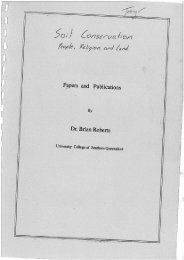western-queensland-gardening-guide.pdf - South West NRM
western-queensland-gardening-guide.pdf - South West NRM
western-queensland-gardening-guide.pdf - South West NRM
Create successful ePaper yourself
Turn your PDF publications into a flip-book with our unique Google optimized e-Paper software.
Fertilising native trees<br />
Most native plants will grow adequately if planted on a suitable site but early<br />
growth rates can be increased by the addition of an appropriate type and amount of<br />
fertiliser. The fertiliser enriches the soil and ensures that plants have the necessary<br />
supply of nutrients. As well as the major nutrients-nitrogen, phosphorus,<br />
potassium, calcium, magnesium and sulphur - trees also require trace elements such<br />
as iron, copper and zinc. The type and quantity of fertiliser used depends on soil<br />
types and conditions, and the species being planted.<br />
Good results from fertilising will only be obtained when weeds and grass around<br />
trees are thoroughly controlled.<br />
Placement of fertiliser<br />
Seedlings and young trees<br />
Fertilisers can be spread in a ring around the tree if the area is relatively Eat, but<br />
should otherwise go in a band on the uphill side of the tree. An alternative method is<br />
to dig one or two small holes 10 cm to 20 cm deep near the tree, place the fertiliser in<br />
the hole and refill with soil. Fertiliser should be 20 cm to 50 cm away from the base<br />
of the tree (See Figure 16).<br />
Figure A 6. Placement of fertiliser<br />
Figure 17. Availability of nutrients
















